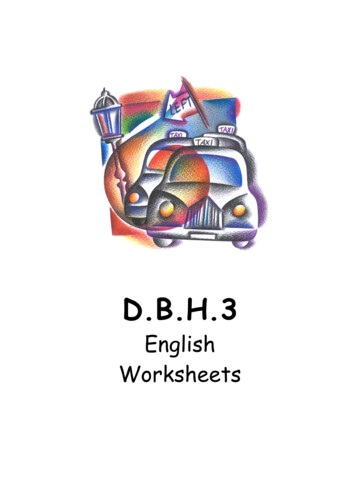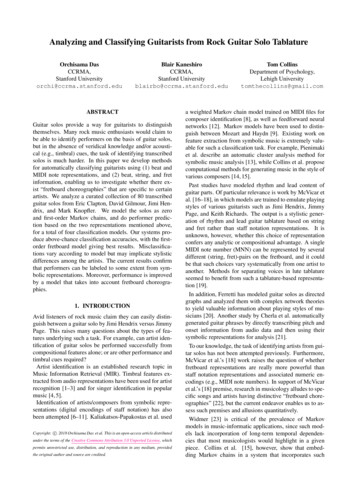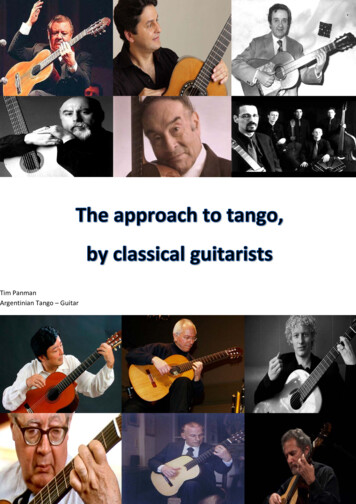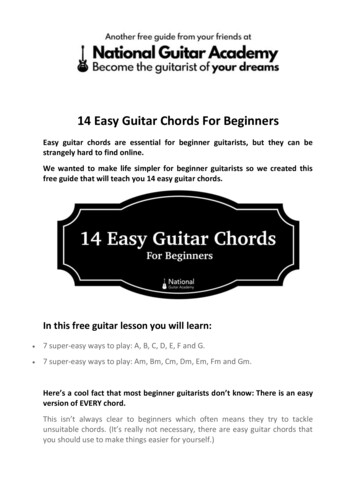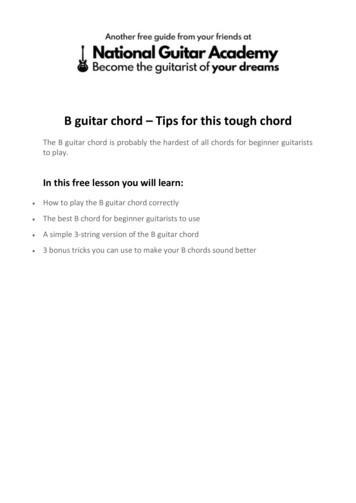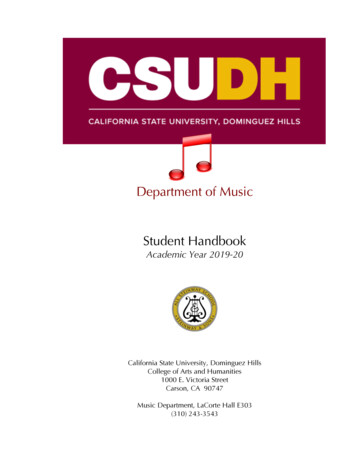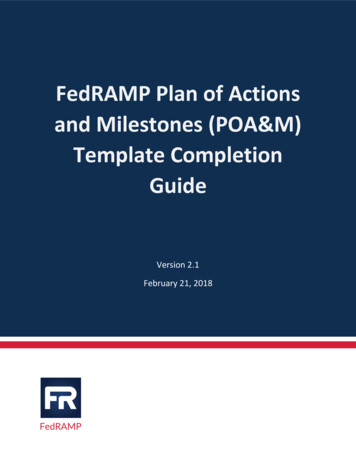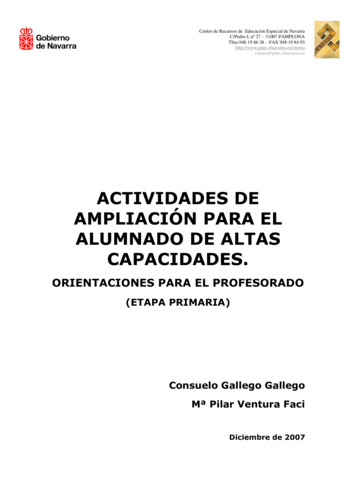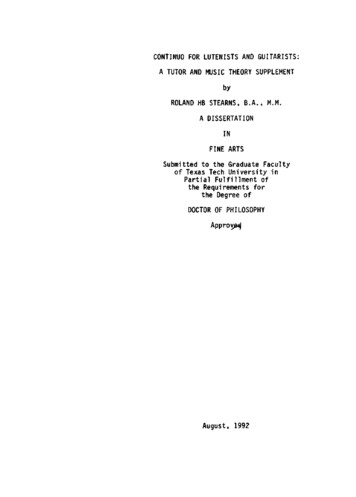
Transcription
CONTINUO FOR LUTENISTS AND GUITARISTS:A TUTOR AND MUSIC THEORY SUPPLEMENTbyROLAND HB STEARNS, B.A., M.M.A DISSERTATIONINFINE ARTSSubmitted to the Graduate Facultyof Texas Tech University inPartial Fulfillment ofthe Requirements forthe Degree ofDOCTOR OF PHILOSOPHYAppro August, 1992
gel/\ ,5'? 'ACKNOWLEDGMENTSThis tutor represents the inspirational ideas and support given by my goodfriends, Stefan Lundgren of Munich, Germany, and Dr. James Bogle, my majorprofessor at Texas Tech University. Of course, without the many past opportunities Ihave had to participate in various kinds of continuo here and in Europe (for which I amhappily indebted), there would be little sense to such a project. Special thanks go alsoto the students of Mr. Lundgren's May, 1988, Kurse fiir Laure (Courses for Lute) inZillertal, Austria, who participated with great success in a trial run of the ideasdeveloped in this tutor. In a single week of intensive studies, we were able to covercontinuo basics in the six introductory pieces contained in this tutor's Part Two,including excursions into more advanced topics, and finally, perform these works withgood success at a small "in house" gathering at the course completion. Additional thanks go to those friends and colleagues whose names may appearin footnotes or, through my unfortunate oversight, have been left out.Finally, I would like also to acknowledge with thanks the assistance of mybrother, Frank, for his knowledge of acoustics and for helping me to establish thecomputer skiUs which have contributed so much to the appearance of this work, to theDell Computer corporation for its superb hardware and support, to NISCACorporation, whose products and "hands on" assistance have contributed sosignificantly to the graphics resources which appear in this tutor. Among them, Albert Davy, Uli Lehmann, Christine Geissler, Hannes Goullon,Werner Faust, Rudolf Perl, Hans Haase, Use Semmelmann, Goran Josefsson, andAngela and Robert Hommes. It should be noted that while none of the Zillertalstudents were professional performers or musicians, some were excellent players.Their accomplishment in inspiring this text will, I hope, encourage other prospectivecondnuo students.11
CONTENTSACKNOWLEDGEMENTSLIST OF TABLESiiixLIST OF INSTRUMENT FIGURESLIST OF MUSICAL WORKSLIST OF QUOTESPREFACExxixiixiiiPART ONEINTRODUCTION AND HISTORICAL BACKGROUNDI. CONTINUO - GENERAL INTRODUCTIONA Layman' s SummaryMonodyA Second PhaseA Third PhaseWhy History?History Versus Practical PedagogyCondnuo - The Need For Historical PerspectiveII. ORIGINS OF CONTINUO - THE SCHOLAR'S VIEWSeventeenth Century DevelopmentsComplicating FactorsCondnuo - General DevelopmentCondnuo Origins in Vocal LiteratureImplications for Modern Lute and Guitar StudiesIn Vocal GenresHistorical Continuo and Modern PedagogyIII. CONTINUO - PRELIMINARY EXAMPLESA Practical Student SummaryCondnuo ExamplesLute as bass obbligato instrumentEarly Chordingfrom dance scoreswritten out continuo and melody lineEarly Figured BassWritten out continuoLater Figured 0
Some Preliminary ConclusionsIV. TONALITY, PITCHES, AND ACCORDATURATonalityAccordaturaPitches - Historical and ModernPART TWOLEARNING TO PLAY CONTINUO3435353839V. CONTINUO PRELIMINARIESSome Brief Pedagogical NotesFor All Prospective StudentsFor The GuitaristScalesBackgroundRecurring Note Groups - The OctaveC-Major octave scaleIntervals Larger than Half and Whole StepsTable 5 . 1 - Intervals and Scale FiguresIntervals in Major/minorBuilding Chords for CondnuoBackgroundStructureC-Majof and minor triadsChords from Scale StepsDoubled Chord Notes, String Doubling, Accidentals, and KeysDoubled Notes from Instrument CoursesAccidentals and KeysVL STARTING TO PLAY - C-MAJORElements of Condnuo Harmonic StyleCourse/String Notes for 8A Final Preparatory C-Major Scale ExerciseA First Musical WorkPlaying Individual LinesThe First Two Chords of C-MajorC-Major-G-Major bass notes and chord forms6061616465CompleUng the Basic C-Major Chord Group66"The Squirrel's Toye" - A Continuo Score68VII. THE DOMINANT (V) OF C-MAJOR AS THE KEY OF G-MAJORAccidentals and Key Signatures7070iv
Rules for AccidentalsPlaying in G MajorCourse/String Notes for G-MajorPreparatory G-Major 1 and 2-Octave Scale ExercisesThe 3-Octave G-Major ScaleA Second Musical WorkPlaying Individual LinesG-Major Chords (I, IV, V)G, C, and D-Major Bass Notes And Chord FormsAccidentals As Condnuo Chord Altering SymbolsIntroducdon to an Altered (Major) ChordA G-Major Exception (The A-Major Barred Chord)A-Major Preparatory Exercise"Gathering Peascods" - A Continuo ScoreVIII. AN INTRODUCTION TO F-MAJORThe Subdominant (IV) Of C-major As A Key - F-majorAccidentals in Key SignaturesF Scale in C - F-Major scale (with Bb in Key Signature)Playing in F-MajorCourse/String Notes for F-MajorF-Major 3-octave ScaleA Third Musical WorkPlaying Individual LinesThe Three Basic Chords of F-Major Plus TwoF, Bb, C, Eb-Major, d-minor bass notes and chord formsReviewing and Condnuing with Chord Altering Symbols"Cortesa Padoana" - A Continuo ScoreIX. CHORD INVERSIONSAn Introduction to InversionsChord Inversion (6, 6/3, 6/4) SymbolsPlaying Basic Chord InversionsA Fourth Musical WorkPlaying Individual Lines"Sellinger's Round" - A Condnuo 99091929394949496989899X. THE PARALLEL MINOR OF G-MAJOR - G-MINOR100Background - Modes and Minor Scales100Chord Function and Accidentals in MinorThe Parallel Minor101101
Harmonic Function and Accidentals in the Minor KeyThe Harmonic MinorThe Melodic MinorCourse/String Notes for g-minorThe G-minor ScalesA Fifth Musical WorkPlaying Individual LinesThe Chords of g-minorG-minor Bass Notes And Chord Exercise"Upon a Summer's Day" - A Condnuo ScoreXL THE RELATIVE MINOR OF F-MAJOR - D-MINORThe D-minor ScalesCourse/String Notes for d-minorA Sixth Musical WorkThe Chords of d-minor"The Siege of Limerick" A Condnuo ScorePART THREEADDITIONAL CONTINUO TOPICS, AND APPENDICESXn. ADDITIONAL CONTINUO TOPICSWhere to Go from HereStylistic Considerations - Handel's "Nel Dolce"ConclusionsInstrumental ConsiderationsBass Strings (Diapasons)Additional Tips for the BeginnerPlucking Techniques with Lute and GuitarThe Chitarrone (Theorbo) in AThe Baroque LuteThe Baroque GuitarThe Condnuo Player as AccompanistAPPENDIX A - OTHER CONTINUO TECHNICAL FEATURESA Guide to Condnuo SymbolsFigured Bass NumbersAccidentalsPart Wridng, Voice Leading, and Non-figured BassesRule of the OctaveVoice Leading 130130131131133133
Four-part Wridng GuidelinesVoice LeadingParts Doubling GuidelinesSeventh ChordsSeventh Chord Symbols and InversionsDiminished Seventh chordsOrnaments134134134134135136137An Introducdon To Non-harmonic Tones139A Summary of Non-Harmonic Tones140Passing Tone140Anticipation140Echappee141Cambiata141Nota Cambiata141Auxiliary (Upper or lower Neighbor)142Changing Tone (Double Upper/lower Neighbor)142Appoggiatura143Suspensions143APPENDIX B - ADDITIONAL KEYS AND WORKS-Bb, D, A-MAJOR, AND C-MINOR145Theory/reading Supplements - (G-g' Accordatura)146Condnuo Supplements153Continuo Supplements in Facsimile156Some Notational Considerations156APPENDIX C - A HARMONIC SYSTEM FROM THE CONTINUO ERA . 166Introducdon166Clarifying Tuning and Temperaments166The Circle of Fifths169From Sharp to Flat Keys171Enharmonic Spellings172APPENDIX D - A BRIEF SUMMARY OF THE LUTE FAMILY173The "Classical" Lutes175Transitional Lutes178Longer Scale Continuo Lutes179Chitarrone180Tiorba, Theorbo, Theorbe180Mid and Short-Scale Baroque Lutes182Arciliuto (Arcileuto)182Archlute, Erzlaute183viiJIL
Liuto Atdorbato184Baroque (Two-headed) Lute186Other Plucked Instruments187Cittern187Cetrone187Mandora, Pandurina187Bandora, Orpharion187Angelique188Penorcon, Poliphant, Stump188APPENDIX E - SOME CONCLUDING GENERAL OBSERVATIONS ONCONTINUO PERFORMANCE PROBLEMS189Expecdng Too Much from a Prepared Realizadon189Salzburg, Musicology, Music Stands, and Dead Rooms190Early and Modern Acoustics versus Modern Instruments192Introduction192Modem Acoustics and Eariy Instruments Early Acoustics and Modern Instruments193Degendorf, Ravenna, and Regensburg193The Condnuo Singer and Acousdcs194Some Brief Conclusions195APPENDIX F - INDEX196BIBLIOGRAPHY204viu
LIST OF TABLES4.1 Lute/Guitar Accordature5.1 Intervals and Scale FiguresC. 1 Pythagorean, Just, Equal, and Meantone TemperamentsIX3949169
LIST OF INSTRUMENT FIGURESFig.Fig.Fig.Fig.Fig.D.lD.2D.3D.4D.5Descant, Alto, Bass LutesTheorbo (d-minor Lute?), Short Theorbo, ChitarroneArchlutes, Liuto AtdorbatoBaroque (Two-headed) LutePandurina176181185186187
LIST OF MUSICAL WORKSTielman Susato, "Mein Verlangen" (1551)Cesare Negri, "Le gratie d'amore" (1602/04)Giulio Caccini, "AmariUi mia bella" (1602)Giulio Caccini, "Amarilli" (piano adaptation)Giulio Caccmi, "Amarilli" (R. Dowland transcription)Giovanni Pittoni, "Sonata I" (1669)G.F. Handel, "Nel dolce dell'oblio" (17?)"The Squirrel's Toye""Cortesa Padoana""Sellinger's Round""Upon a Summer's Day""The Siege of Limerick""Lo How a Rose e're blooming""Herr Jesu Christ""Praise to God (Old 100th)""On Jordan's Bank""Rejoice, believers""GodRest Ye Merry Gentlemen""What Child""Lord, dismiss us with Thy blessing""Father Eternal""Christ Lag in Todesbanden""Per Pianto la mia came" (Leonora Orsina)"Se in me, donna, movete" (Sigismondo d'India)Sonata V, Adagio (Johann Ernst Galliard)"Lob der Keuscheit" (Gabriel Voigtlander)Sonata a Tre (Trio Sonata) (A. Corelli)"AmarilU" (G. Caccini, Complete 49150151151152153155157158159164
LIST OF QUOTESNigel North on beginning condnuo student qualifications (fn.)Arnold Schoenberg on decline of figured bass playingNigel North on continuo bass doublingxiii47Tharald Borgir on condnuo bass doublingTharald Borgir summarizing continuo originsTharald Borgir, quoting H. Collin Slim on eariy condnuo (fn.)Giulio Caccini on preferred continuo accompaniment (fn.)Tharald Borgir on bass-line doubling (fn.)Benedetto Marcello sadre on composers and theoryNigel North on variable continuo rulesNicola Matteis on the baroque guitar in continuoCaspar Sanz on baroque guitar tunings (fn.)Nigel North on limited historical information about ornamentsAgosdno Agazzari on ormanentationNigel North on avoiding too-thick condnuo textures (fn.)7911111651112124125137139189xn
PREFACEThis is not the first modem pedagogical effort on the subject of continuo forplucked instruments, and to those who can eventually go beyond beginning levels Isuggest the fine book by Nigel North Cominuo Play in 2 on the Lute, Archlute andTheorbo. However, there are many good reasons for yet another tutor for prospectivecontinuo players. One of them is the substantial cost that Mr. North's book entails forthe novice while it, along with other literature on the subject, fails to address somecrucial beginner issues: These sources cannot or do not detail how the modern beginner, whoclearly has grown up in a different musical culture, may build astep-by-step knowledge of reading bass lines and supplying basiccontinuo harmonies without a bewildering number of alternativesthat might needlessly confuse him while adding nothing to themusic itself They largely ignore literature (in particular, that of the dance) whichis ideally suited to learning the highly important processes ofquick continuo thinking (or perhaps even "non-thinking, correctreaction") that is more suitable for building beginner confidencethan a morass of voice leading rules whose results can gounheard, and whose application (while admittedly important inthe right places) belongs to more advanced playing (details ofwhich will be explored in this tutor); Another missing feature is the consideration of guitarists as potentialcontinuo players. While the modern guitar is out of place as anhistorical continuo instrument, the effective dismissal of itsstudents from an opportunity to study "new" music and relatedinstruments with an initial available resource (guitar) is as selfdefeating and just as difficult to accept as would be its oppositesetting - a collection of modern classical guitars appearing inMonteverdi's opera, L'Orfeo: Finally, works such as Mr. North's (Jiowevcr graphically superb) thatcontain a prolixity of historical detail can cause a beginner to Nigel North, Continuo Playing on the Lute. Archlute and Theorbo(London/Boston, Faber Music Ltd., 1987), 305 pp. In fact, Mr. North discounts the beginner entirely with his assertion (on p. xi)that, "players wishing to benefit from this book should have an advanced playingability on the (Renaissance) lute and should be able to read staff notation fluendy onthat instrument." Unfortunately for most, it is often from condnuo-related studies thatsuch notational skids develop in thefirstplace.xiii
find himself in a quagmire of intimidating musical andinstrumental alternatives withoutfirsthaving achieved a workingfacility with continuo basics. Something more accessible andfunctional is needed.Related to the above considerations of expense and potential player audiencemight be Mr. North's discussion of instruments and his stated need for the novice tohave one. Although such discussions are potentially valuable, the beginner oftenalready has some instrument and cannot afford another from the many cosdy optionsavailable until he knows the musical sryle(s) and period(s} which he prefers to plav. orfor which other performers/performance opportunities are available.Thus my approach in this tutor is first and foremost a musical one, employingeasier-to-play works than those typical of later, more specialized instruments/styles.The use of a guitar, perhaps with capotasto (capo) to approximate shorter lutefingerboard and pitch, is a perfectly acceptable first study option. For lutenists, muchcontinuo music can be rendered on a smaller renaissance 7 or 8-course lute traditionallyassociated with solo literature. Thus a student with limited resources or who isundecided about his preferences in literature and instruments might achieve an initiallymore practical, two-fold objective of continuo and other repertoire studies.In general terms this tutor is designed to provide a bridge to more advancedstudies for the very beginner, and it presumes some knowledge of tablature or guitarnotation, or in some cases, keyboard. It is not intended as a "self-tutor" althoughstudents with enough musical knowledge may, with care, use it that way. However,continuo is a social music medium, and, unlike solo works, cannot be mastered withoutsecond or third (or more) musical participants. One should be forewarned to patience,and that continuo playing, while often every bit as rewarding as more difficult soloplaying, may require more dedication and imagination than when undertaken with anincomplete complement of players.There are several other important sources of information for the professionallyinclined continuo player, the most important of which is perhaps the monumental 19thcentury work by F.T. Arnold, The Art of Accompaniment from a Thorough-bass. . .' And with the small, but all-important retuning of the guitar's third string downone half-step." F.T. Arnold, The Art of Accompaniment from a Tfiorough-bass as Practised inxiv
More recendy, the exceptional book by Robert Donington, 77? Interpretation of EarlyMusic, holds valuable continuo insights. Any articles about continuo from the Englishlanguage 6th edition of 77?g Grove Dictionary of Music and Musicians or German, DieMusik in Geschichte und Gegenwart (MGG) should also provide valuable supplementsto this tutor. Most valuable to this study (and would also be to all prospective continuostudents) has been Tharald Borgir's. The Performance of the Basso Continuo in ItalianBaroque Music. a work as rich in practical reality about continuo as it is in scholarlyinsight.With one exception (a 1680-82 tutor by Nicola Matteis which holds valuableinformation for guitarists and those in related music theory areas ), I have avoidedtheXVIIth & XVIIIth Centuries, reprinted. (2 Vols.), (London: Holland Press, 1931,61), 918 pp. (Also reprinted in New York: Dover Publications, 2 vols., thoughcurrendy not available.) Readers should be warned that while Amold's work isunquestionably valuable, especially for its examination of treatises and the harmoniccomplexities of the later continuo style, his conclusions about much of the performancepractice (such as then necessity of bass melody instrument rather than the option of asingle lute or theorbo accompaniment) are not accurate according to modem research(by Tharald Borgir, for example, whose work is pivotal in the support of this tutor'sapproach).Robert Donington, 77? Interpretation of Early Music, new edition (New York:St. Martin's Press, 1974).Tharald Borgir, 77? Performance of the Basso Continuo in Italian BaroqueMusic (Ann Arbor, MI: UMI Research Press, 1977, 1987), 180 pp. Mr. Borgirmentions a somewhat earlier study {"Solo Sonata, Duo Sonata, and Trio Sonata. SomeProblems of Terminology and Genre in 17th Century Italian Instrumental Music,"Festschrift. J.P. Larsen, ed. Edition Schioring, et al. Copenhagen: W. Hansen, 1972,pp. 73-101), by a N. M. Jensen (only first initials given). According to Borgir, Mr.Larsen apparendy arrived at conclusions similar to Borgir's, though neither had beenfamiliar with the other's work.7The book, a facsimile reprint of the Glasgow University Library's copy oi The.False consonances of Musick. with introduction by guitarist scholar, James Tyler(Monaco: Editions Chanterelle S.A., 1980. 96 pp.), gives valuable examples of howguitarists of this period effectively employed an instrument without an extensive bassregister in what is essentially a lower register art form, i.e., continuo accompaniment.Chapter XII of this tutor provides specific examples from Matteis' work (p. 126).XV
references in this tutor to early or "historical" continuo methods, nearly all of whichappear much after 1600. Continuo in its most "sophisticated" states (perhaps from1650 on) might have been as foreign to some of its 16th century founders as it is to a20th century novice. Period tutors also had the certain advantage of an audience whose"ear" was more attuned to the continuo style and whose members had relatively quickaccess to special instruments of the period, something a modem pedagogue cannotassume among his students.Bridging such historical gaps between past and present with the freshest possiblestart has been a prime consideration in structuring this beginner's work. A student isgenerally more prepared to deal with the special problems of a given historical method(especially the oft-occurring unusual language and notational features) after he hasstudied basics in a method which avoids such distractions. This tutor is offered toprovide such preparation.In those cases where my explanations may seem excessively "basic," the studentor instructor should, with some caution, feel free to scan ahead until he finds moreappropriate material. In fact, the idea of a basic continuo tutor goes hand-in-hand withthe need for a university music harmony supplement for guitarists and lutenists whomay often and unfairly feel inadequate to the demands of modem theory classes incomparison to more facile keyboard students when, ironically, it was instrumentsbelonging to the former group which were so crucial to the development of mainstreamwestem harmony. In truth, much of the impetus for offering my own pedagogicalapproach has been inconsistencies I have experienced in my own musical training. Ihad always wished to play "early" instruments (which historians required me to beaware of as part of the Renaissance and Baroque staple), but there was the impossibletask of using such instruments in theory classes to study the contemporary practices inwhich those instruments had ceased to play a central part. Thus this tutor is offered inhopes of achieving some further integration, rather than inaccurate segregation, ofmusic history and theory.Throughout this work 1 shall italicize and/or underline certain words or phrases(ex., continuo, alfabeto) for pedagogical emphasis, and here recommend that theserious student, with discretion and teacher assistance, be sure to commit anydefinitions of recurring terms to memory. Whenever possible, 1 will providedefinitions for terms as they are introduced, adding them by name in the Indexxvi
(Appendix F, p. 196) which will also be arranged to function, in effect, as a glossary).Finally, because this tutor constitutes a kind of teacher-to-student writing, itshould not be taken as an absolute model for students wishing to engage in their ownresearch. It is being written under one of three options in a program specially designedto allow either a full research dissertation, or a different, less restrictive project.Teaching a subject contains wholly different options for an author who, in the case of adissertation, should strive dispassionately impersonally to research a subject and writeabout it. A pedagogical theme whose essential features include subjective artisticexpression, or involve the important aspect of a teacher's personal influence inmotivating a student, requires a less rigid framework. Therefore, while I haveemployed general scholarly procedures (for example, in corroborating research andreferences), a student should be cautioned not to view my various emphases andsubjective additions as academic example, but instead as pedagogical highlights hemight encounter working directly with a teacher who has a point to make.XVll
PART ONEINTRODUCTION AND HISTORICAL BACKGROUND
CHAPTER ICONTINUO - GENERAL INTRODUCTIONA Layman's SummaryIn the most basic terms, continuo is little more than a specialized form ofimprovising harmony using composer-supplied bass notes, usually to accompany one ormore melodies above. In addition to its melodic and harmonic features, continuo isdistinguished in this manner of improvisation by its special set of descriptive symbolsand, of course, its performance mediums. These characteristics overlap, thus adding tothe complexity of things. For example, although many harmonic conventions featuredin continuo are to be found in music prior to its origins in the 1580's, one might notimmediately recognize this in such works because the special symbols and scoringformats developed for continuo did not come into common use until the early 1600's.MonodyAmong the first works exhibiting commonly accepted continuo features werethose by early composers of monody. This compositional style, inspired by ideals setforth by the so-called Florentine Came rata.- purported to escape the complexities ofmulti-voiced renaissance polyphony and recapture the simple ideals of antiquity, of The reader should be aware that among the many available terms, I will hereon out use "continuo" as an expedient, general name for a style which has had many(including y/ wr and thorough bass among others). Borgir's The Performance of theBasso Continuo. pp. 12-13, lists some 14 terms for continuo in Italy alone from 1594to 1616. These were spartitura (Venice, 1594, G. Croce), partidura (1596, Venice,G. Croce). partito (1598, Milan, J. Gallus), basso principale (1598, Milan, OrfeoVecchi), basso per I'orsano (1599, Milan, G. Bassano), parte de i bassi (1599,Venice, "eight.authors"), basso continuato (1600, Rome, E. de' Cavalieri, in hishistorically important "Rappresentatione di anima e di corpo"), basso generale (1600,Venice, G. Fattorini), gravium partium (1602, Venice, G. Zucchini), basso continuo(1603, Venice, L. Grosso da Viadana), partimento. (1605, Venice, G.M. Trabaci),basso sequente (1607, Venice, A. Banchieri), basso sequito (1610, Venice, G.Piccinoi), and partitione (1616, Naples, M. Trabaci). Apparendy, those employingvariations on the verb, "spartire" tended toward southem Italy, while variations using"basso" tended to be from the north. Additional details on this association appear on p. 14 and fn. 15 of the samesection.
3music supporting, not obscuring, a text. Typically, this meant as few instruments aspossible, and as the name monody implies, one singer. The instrument created for thiscontext was the chitarrone.' a giant member of lute family (often over six feet long),ostensibly a reconstruction of Apollo's harp or kithara. The etymological relationshipof the borrowed and adapted Italian "chitarrone" to the Greek "Kithara" may beapparent, and extends the idea of reclaiming ancient dramatic ideals to instruments.A Second PhaseThe heyday of monody lasted at most from about 1580 to 1610-20, andthereafter, continuo began to evolve into the exact opposite of its originators' intentions(as exemplified by later baroque works of Bach, Handel, and others). Simplicity againgave way to complexity. Single line monody yielded to solo arias and operaticensembles while monody's legacy remained in the quasi-speech of recitative (It.,recitativo), where it helped maintain a dramatic story line; simple, single instrumentalaccompaniment grew to entire orchestras. In these various ensembles (ranging fromtwo or three to thirty or more instruments and voices), continuo played a vitalunderlying role, though by 1680, a single instrument was often no longer able to haveenough of an impact on the musical texture, and so multiple instruments in variouscapacities became the standard. This trend began to be evident even in the early1600's, for example in Claudio Monteverdi's calling for more than one instrument on agiven part in his works. Consult this tutor's Appendix D, p. 169 , or North, pp. 3-15, for specifics onquestions concerning instrument appearance, tuning, and so forth." Suggested by Robert Spencer in his indispensable article, "Chitarrone,Theorbo, and Archlute" (p. 410), in Eariy Music. Vol. 4, No. 4 (1976), pp. 407-423.The earliest examples of the chitarrone (ca. 1589) were likely created from a revampedor borrowed bass lute design. Douglas Alton Smith, "On the Origin of theChitarrone," The Joumal of the American Musicological Society (JAMS), XXXII/3(1979): 440-62, accurately details the interesting story of this instrument'sdevelopment. See Appendix D, p. 169, for additional instrumental descriptions. The composer's 1607 score of the opera, L'Orfeo. calls for "duoi chitarroni,"later (1615) adding two metal-strung cetrone as well. Readers interested in the idea ofearly continuo instrumentation might well browse collections such as the Tutte le Operedi Claudio Monteverdi. Gian Francesco Malipiero, ed. (2nd ed., Vienna: UniversalEditions, 1967), or in other editions such as the facsimile of the 1615 Venice
A Third PhaseDuring the mid-17th-century, continuo had ceased to be primarily a simpleaccompaniment technique, and with changes in musical style and performanceaudiences, developed into what was to become an accepted standard for this style inwhat we wiU see was the sometimes narrow view of post-19th century researchers.The musical framework of this continuo consisted of a plucked (keyboard or lute)instrument, sustained bass melody (or obbligato) instrument, and upper lineinstmment(s). Special symbols (i.e., numbers and modifications to them that musicianshad to learn) indicated harmonies (additional notes) which could not easily be deducedfrom those present.It is just as important, however, to avoid tuming the above described norm intoa new continuo historical dogma. There were early examples of larger ensembles inwhich a lutenist might not be the sole continuo accompanist, simply as a practicalmatter of being heard. On the other hand, the basis for studying continuo for theplucked instrument player unquestionably has its roots in the above first and secondphases of continuo (early lute accompaniment and monody), and it is these areas whichform the basis for this tutor. Defining continuo through accurate history is crucial toachieving expertise in playing it, and I suggest examining the following sections beforeand during work on the pieces in Parts Two and Three.Why History?The idea of continuo has in the last twenty years undergone a kind of "followon" revival generally accepted to have been inspired by the mid-20th-century renewalof interest in the instruments on which the continuo style itself developed in the 16thand 17th centuries. Composer Amold Schoenberg, writing prior to this revival as atheorist about the art of "figured bass" (practically speaking, a reference to the finalpublication, L'Orfeo. Fayola in Musica, Denis Stevens, ed. (Westmead, England:Gregg Intemational Publishers Limited, 1972). Borgir summarizes these on p. 50 as being exceptions in solo, concerted, andsacred works where bass doubling might first have begun to appear.
historical development of continuo), laments that his generation was, "the last to knowit. "7While Schoenberg's reference may have been more to the art of keyboardcontinuo in relation to post-baroque theory, (and at that, of continuo at its mostcomplex), his statement also may have hit upon a more general problem. Continuomust be placed in a more intelligible context if it is to have much meaning formusicians in general and lutenists and/or guitarists in particular, who, after all, wereamong the principal musicians by and for whom the art form was created. Its modemperformance would be enhanced were its instruction to proceed on an historical basisradier than one of a post-17th century harmonic/a/r accompli. Why this is so,especially so in terms of modem pedagogy, will become increasingly apparent inforthcoming sections.Because continuo itself was as much the art of quick musical thinking as ofcorrect process, several modem textbook factors combine to intimidate a lutenist orguitarist in ways perhap
CONTINUO FOR LUTENISTS AND GUITARISTS: A TUTOR AND MUSIC THEORY SUPPLEMENT by ROLAND HB STEARNS, B.A., M.M. A DISSERTATION IN FINE ARTS Submitted to the Graduate Faculty of Texas Tech University in Partial Fulfillment of the Requirements for the Degree of DOCTOR OF PHILOSOPHY Appro August, 1992
